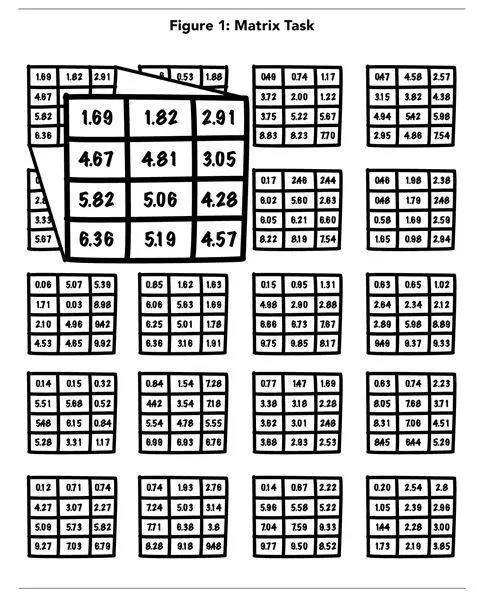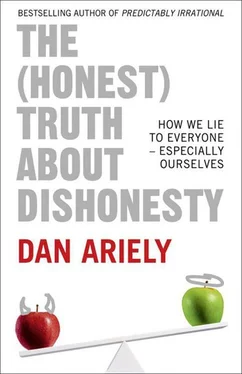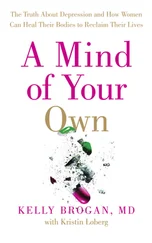Ariely, Dan - The (Honest) Truth About Dishonesty - How We Lie to Everyone – Especially Ourselves
Здесь есть возможность читать онлайн «Ariely, Dan - The (Honest) Truth About Dishonesty - How We Lie to Everyone – Especially Ourselves» весь текст электронной книги совершенно бесплатно (целиком полную версию без сокращений). В некоторых случаях можно слушать аудио, скачать через торрент в формате fb2 и присутствует краткое содержание. Жанр: Старинная литература, на английском языке. Описание произведения, (предисловие) а так же отзывы посетителей доступны на портале библиотеки ЛибКат.
- Название:The (Honest) Truth About Dishonesty: How We Lie to Everyone – Especially Ourselves
- Автор:
- Жанр:
- Год:неизвестен
- ISBN:нет данных
- Рейтинг книги:4 / 5. Голосов: 1
-
Избранное:Добавить в избранное
- Отзывы:
-
Ваша оценка:
- 80
- 1
- 2
- 3
- 4
- 5
The (Honest) Truth About Dishonesty: How We Lie to Everyone – Especially Ourselves: краткое содержание, описание и аннотация
Предлагаем к чтению аннотацию, описание, краткое содержание или предисловие (зависит от того, что написал сам автор книги «The (Honest) Truth About Dishonesty: How We Lie to Everyone – Especially Ourselves»). Если вы не нашли необходимую информацию о книге — напишите в комментариях, мы постараемся отыскать её.
The (Honest) Truth About Dishonesty: How We Lie to Everyone – Especially Ourselves — читать онлайн бесплатно полную книгу (весь текст) целиком
Ниже представлен текст книги, разбитый по страницам. Система сохранения места последней прочитанной страницы, позволяет с удобством читать онлайн бесплатно книгу «The (Honest) Truth About Dishonesty: How We Lie to Everyone – Especially Ourselves», без необходимости каждый раз заново искать на чём Вы остановились. Поставьте закладку, и сможете в любой момент перейти на страницу, на которой закончили чтение.
Интервал:
Закладка:
On the next page is a sample of what the sheet of paper looked like, with one matrix enlarged. How quickly can you find the pair of numbers that adds up to 10?

This was how the experiment started for all the participants, but what happened at the end of the five minutes was different depending on the particular condition.
Imagine that you are in the control condition and you are hurrying to solve as many of the twenty matrices as possible. After a minute passes, you’ve solved one. Two more minutes pass, and you’re up to three. Then time is up, and you have four completed matrices. You’ve earned $2. You walk up to the experimenter’s desk and hand her your solutions. After checking your answers, the experimenter smiles approvingly. “Four solved,” she says and then counts out your earnings. “That’s it,” she says, and you’re on your way. (The scores in this control condition gave us the actual level of performance on this task.)
Now imagine you are in another setup, called the shredder condition, in which you have the opportunity to cheat. This condition is similar to the control condition, except that after the five minutes are up the experimenter tells you, “Now that you’ve finished, count the number of correct answers, put your worksheet through the shredder at the back of the room, and then come to the front of the room and tell me how many matrices you solved correctly.” If you were in this condition you would dutifully count your answers, shred your worksheet, report your performance, get paid, and be on your way.
If you were a participant in the shredder condition, what would you do? Would you cheat? And if so, by how much?
With the results for both of these conditions, we could compare the performance in the control condition, in which cheating was impossible, to the reported performance in the shredder condition, in which cheating was possible. If the scores were the same, we would conclude that no cheating had occurred. But if we saw that, statistically speaking, people performed “better” in the shredder condition, then we could conclude that our participants overreported their performance (cheated) when they had the opportunity to shred the evidence. And the degree of this group’s cheating would be the difference in the number of matrices they claimed to have solved correctly above and beyond the number of matrices participants actually solved correctly in the control condition.
Perhaps somewhat unsurprisingly, we found that given the opportunity, many people did fudge their score. In the control condition, participants solved on average four out of the twenty matrices. Participants in the shredder condition claimed to have solved an average of six—two more than in the control condition. And this overall increase did not result from a few individuals who claimed to solve a lot more matrices, but from lots of people who cheated by just a little bit.
More Money, More Cheating?
With this basic quantification of dishonesty under our belts, Nina, On, and I were ready to investigate what forces motivate people to cheat more and less. The SMORC tells us that people should cheat more when they stand a chance of getting more money without being caught or punished. That sounds both simple and intuitively appealing, so we decided to test it next. We set up another version of the matrix experiment, only this time we varied the amount of money the participants would get for solving each matrix correctly. Some participants were promised 25 cents per question; others were promised 50 cents, $1, $2, or $5. At the highest level, we promised some participants a whopping $10 for each correct answer. What do you think happened? Did the amount of cheating increase with the amount of money offered?
Before I divulge the answer, I want to tell you about a related experiment. This time, rather than taking the matrix test themselves, we asked another group of participants to guess how many answers those in the shredder condition would claim to solve correctly at each level of payment. Their predictions were that the claims of correctly solved matrices would increase as the amount of money went up. Essentially, their intuitive theory was the same as the premise of the SMORC. But they were wrong. It turned out that when we looked at the magnitude of cheating, our participants added two questions to their scores on average, regardless of the amount of money they could make per question. In fact, the amount of cheating was slightly lower when we promised our participants the highest amount of $10 for each correct answer.
Why wouldn’t the level of cheating increase with the amount of money offered? Why was cheating slightly lower at the highest level of payment? This insensitivity to the amount of reward suggests that dishonesty is most likely not an outcome of a cost-benefit analysis. If it were, the increase in the benefit (the amount of money offered) would lead to more cheating. And why was the level of cheating lowest when the payment was greatest? I suspect that when the amount of money that the participants could make per question was $10, it was harder for them to cheat and still feel good about their own sense of integrity (we will come back to this later). At $10 per matrix, we’re not talking about cheating on the level of, say, taking a pencil from the office. It’s more akin to taking several boxes of pens, a stapler, and a ream of printer paper, which is much more difficult to ignore or rationalize.
To Catch a Thief
Our next experiment looked at what might happen if participants felt that there was a higher probability of getting caught cheating. Basically, we inserted the mental equivalent of a partially operating security camera into the experiment.
We asked one group of participants to shred one half of their worksheet—which meant that if they were dishonest, we might find some evidence of it. We asked a second group to shred the whole work sheet, meaning that they could get off scot-free. Finally, we asked a third group to shred the whole worksheet, leave the testing room, and pay themselves from a sizable bowl of money filled with more than $100 in small bills and coins. In this self-paying condition, participants could not only cheat and get away with it, but they could also help themselves to a lot of extra cash.
Again, we asked a different group to predict how many questions, on average, participants would claim to solve correctly in each condition. Once again, they predicted that the human tendency for dishonesty would follow the SMORC and that participants would claim to solve more matrices as the probability of getting caught decreased.
What did we find? Once again, lots of people cheated, but just by a bit, and the level of cheating was the same across all three conditions (shredding half, shredding all, shredding all and self-paying).
NOW, YOU MIGHTwonder if the participants in our experiments really believed that in our experimental setting, they could cheat and not get caught. To make it clear that this was indeed the case, Racheli Barkan (a professor at Ben-Gurion University of the Negev), Eynav Maharabani (a master’s candidate working with Racheli), and I carried out another study where either Eynav or a different research assistant, Tali, proctored the experiment. Eynav and Tali were similar in many ways—but Eynav is noticeably blind, which meant that it was easier to cheat when she was in charge. When it was time to pay themselves from the pile of money that was placed on the table in front of the experimenter, participants could grab as much of the cash as they wanted and Eynav would not be able to see them do so.
Читать дальшеИнтервал:
Закладка:
Похожие книги на «The (Honest) Truth About Dishonesty: How We Lie to Everyone – Especially Ourselves»
Представляем Вашему вниманию похожие книги на «The (Honest) Truth About Dishonesty: How We Lie to Everyone – Especially Ourselves» списком для выбора. Мы отобрали схожую по названию и смыслу литературу в надежде предоставить читателям больше вариантов отыскать новые, интересные, ещё непрочитанные произведения.
Обсуждение, отзывы о книге «The (Honest) Truth About Dishonesty: How We Lie to Everyone – Especially Ourselves» и просто собственные мнения читателей. Оставьте ваши комментарии, напишите, что Вы думаете о произведении, его смысле или главных героях. Укажите что конкретно понравилось, а что нет, и почему Вы так считаете.












